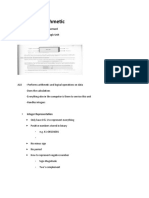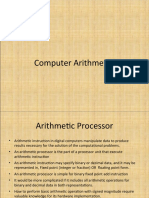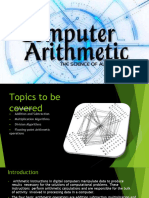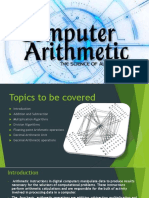0 ratings0% found this document useful (0 votes)
24 viewsLecture 4 - Computer Arithmetic
This document summarizes a lecture on computer arithmetic. It discusses the ALU and its role in performing arithmetic and logical operations. It then covers different methods for representing signed integers in binary, including sign-magnitude and twos' complement representations. The key advantages of twos' complement are explained. Addition, subtraction and multiplication operations on integers in twos' complement format are also summarized.
Uploaded by
Me meCopyright
© © All Rights Reserved
Available Formats
Download as PDF, TXT or read online on Scribd
0 ratings0% found this document useful (0 votes)
24 viewsLecture 4 - Computer Arithmetic
This document summarizes a lecture on computer arithmetic. It discusses the ALU and its role in performing arithmetic and logical operations. It then covers different methods for representing signed integers in binary, including sign-magnitude and twos' complement representations. The key advantages of twos' complement are explained. Addition, subtraction and multiplication operations on integers in twos' complement format are also summarized.
Uploaded by
Me meCopyright
© © All Rights Reserved
Available Formats
Download as PDF, TXT or read online on Scribd
You are on page 1/ 45
COMPUTER ARCHITECTURE
LECTURE 4
BY NDUMISO E. KHUMALO
COMPUTER ARITHMETIC
BITCA3111 COMPUTER ARCHITECTURE 1
Objective
• ALU
• Data Representation
• Signed and unsigned number
• arithmetic operation
• application of complements
• floating point representation
BITCA3111 COMPUTER ARCHITECTURE 2
ALU
• The ALU is that part of the computer that actually
performs arithmetic and logical operations on data
• All of the other elements of the computer
system—control unit, registers, memory, I/O—are
there mainly to bring data into the ALU for it to
process and then to take the results back out
BITCA3111 COMPUTER ARCHITECTURE 3
ALU
• An ALU and indeed, all electronic components in
the computer, are based on the use of simple
digital logic devices that can store binary digits
and perform simple Boolean logic operations.
• Operands for arithmetic and logic operations are
presented to the ALU in registers, and the results
of an operation are stored in registers.
– These registers are temporary storage locations within
the processor that are connected by signal paths to the
ALU
BITCA3111 COMPUTER ARCHITECTURE 4
ALU
• The ALU may also set flags as the result of an
operation.
– E.g., an overflow flag is set to 1 if the result of a
computation exceeds the length of the register into
which it is to be stored.
– ALU IMPUTS
AND OUTPUTS
BITCA3111 COMPUTER ARCHITECTURE 5
Number Representation
• In the binary number system, arbitrary numbers
can be represented with just the digits zero and
one, the minus sign (for negative numbers), and
the period, or radix point (for numbers with a
fractional component).
– -1101.01012 = -13.312510
• For purposes of computer storage and processing,
however, we do not have the benefit of special
symbols for the minus sign and radix point
BITCA3111 COMPUTER ARCHITECTURE 6
Number Representation
• Only binary digits (0 and 1) may be used to
represent numbers.
• If we are limited to nonnegative integers, the
representation is straightforward.
• An 8-bit word can represent the numbers from 0 to
255
• In fact an n-bit word can represent the numbers 0
to 2n-1
BITCA3111 COMPUTER ARCHITECTURE 7
Number Representation:
Sign-Magnitude Representation
• There are several alternative conventions used to
represent negative as well as positive integers, all
of which involve treating the most significant
(leftmost) bit in the word as a sign bit.
– If the sign bit is 0, the number is positive; if the sign bit
is 1, the number is negative.
• The simplest form of representation that employs a
sign bit is the sign-magnitude representation.
– In an n-bit word, the rightmost n - 1 bits hold the
magnitude
BITCA3111 COMPUTER ARCHITECTURE 8
Number Representation:
Sign-Magnitude Representation
• Eg
– +18 = 00010010
– -18 = 10010010 (sign magnitude)
• There are several drawbacks to sign-magnitude
representation
– One is that addition and subtraction require a
consideration of both the signs of the numbers & their
relative magnitudes to carry out the required operation.
BITCA3111 COMPUTER ARCHITECTURE 9
Number Representation:
Sign-Magnitude Representation
– Another drawback is that there are two representations
of 0:
• + 010 = 00000000
• - 010 = 10000000 (sign magnitude)
• Because of these drawbacks, sign-magnitude
representation is rarely used in implementing the
integer portion of the ALU.
• Instead, the most common scheme is twos
complement representation.
BITCA3111 COMPUTER ARCHITECTURE 10
Number Representation:
Twos Complement Representation
• twos complement representation uses the most
significant bit as a sign bit, making it easy to test
whether an integer is positive or negative
• It differs from the use of the sign-magnitude
representation in the way that the other bits are
interpreted.
BITCA3111 COMPUTER ARCHITECTURE 11
Number Representation:
Twos Complement Representation
• Characteristics of Twos Complement
Representation and Arithmetic
BITCA3111 COMPUTER ARCHITECTURE 12
Number Representation:
Twos Complement Representation
• Consider an n-bit integer, A, in twos complement
representation.
– If A is positive, then the sign bit, an-1, is zero.
– The remaining bits represent the magnitude of the
number in the same fashion as for sign magnitude
– The number zero is identified as positive and therefore
has a 0 sign bit and a magnitude of all 0s.
BITCA3111 COMPUTER ARCHITECTURE 13
Number Representation:
Twos Complement Representation
• We can see that the range of positive integers that
may be represented is from 0 (all of the magnitude
bits are 0) through 2n-1 - 1 (all of the magnitude
bits are 1).
– Any larger number would require more bits.
• Now, for a negative number A(A 6 0), the sign bit,
an-1, is one.
– The remaining n - 1 bits can take on any one of 2n-1
values.
BITCA3111 COMPUTER ARCHITECTURE 14
Number Representation:
Twos Complement Representation
• Therefore, the range of negative integers that can
be represented is from -1 to -2n-1.
• We would like to assign the bit values to negative
integers in such a way that arithmetic can be
handled in a straightforward fashion, similar to
unsigned integer arithmetic.
– In unsigned integer representation, to compute the
value of an integer from the bit representation, the
weight of the most significant bit is +2n-1
BITCA3111 COMPUTER ARCHITECTURE 15
Number Representation:
Twos Complement Representation
• What about if the weight of the most significant
bit is -2n-1?
BITCA3111 COMPUTER ARCHITECTURE 16
Number Representation:
Integer Arithmetic
• In sign-magnitude representation, the rule for
forming the negation of an integer is simple: invert
the sign bit.
• In twos complement notation, the negation of an
integer can be formed with the following rules
– Take the Boolean complement of each bit of the
integer (including the sign bit). That is, set each 1 to 0
and each 0 to 1.
– Treating the result as an unsigned binary integer, add
BITCA3111 COMPUTER ARCHITECTURE 17
Number Representation:
Integer Arithmetic
• This two-step process is referred to as the twos
complement operation, or the taking of the twos
complement of an integer
– +18 = 00010010 (twos complement)
bitwise complement = 11101101 + 1 =11101110 = -18
– As expected, the negative of the negative of that number
is itself:
• -18 = 11101110 (twos complement)
bitwise complement = 00010001+ 1 = 00010010 = +18
BITCA3111 COMPUTER ARCHITECTURE 18
Number Representation:
Integer Arithmetic
• Addition
– Addition proceeds as if the two numbers were unsigned
integers
– If the result of the operation is positive, we get a
positive number in twos complement form, which is the
same as in unsigned-integer form
– If the result of the operation is negative, we get a
negative number in twos complement form
• Note that, in some instances, there is a carry bit beyond the
end of the word, which is ignored.
BITCA3111 COMPUTER ARCHITECTURE 19
Number Representation:
Integer Arithmetic
• Addition
– On any addition, the result may be larger than can be
held in the word size being used.
– This condition is called overflow.
• When overflow occurs, the ALU must signal this fact so that
no attempt is made to use the result
– To detect overflow, the following rule is observed:
• overflow rule: If two numbers are added, and they are both
positive or both negative, then overflow occurs if and only if
the result has the opposite sign.
BITCA3111 COMPUTER ARCHITECTURE 20
Number Representation:
Integer Arithmetic
• Addition of Numbers in Twos Complement
Representation
BITCA3111 COMPUTER ARCHITECTURE 21
Number Representation:
Integer Arithmetic
• SUBTRACTION
– subtraction rule: To subtract one number (subtrahend)
from another(minuend), take the twos complement
(negation) of the subtrahend and add it to the minuend.
BITCA3111 COMPUTER ARCHITECTURE 22
Number Representation:
Integer Arithmetic
• Subtraction of Numbers in Twos Complement
Representation (M - S)
BITCA3111 COMPUTER ARCHITECTURE 23
Number Representation:
Integer Arithmetic
• MULTIPLICATION
– Compared with addition and subtraction, multiplication
is a complex operation, whether performed in hardware
or software
– the multiplication of unsigned binary integers, as might
be carried out using paper and pencil. Several important
observations can be made:
• 1. Multiplication involves the generation of partial products,
one for each digit in the multiplier. These partial products are
then summed to produce the final product.
BITCA3111 COMPUTER ARCHITECTURE 24
Number Representation:
Integer Arithmetic
• MULTIPLICATION
• 2. The partial products are easily defined. When the multiplier
bit is 0, the partial product is 0. When the multiplier is 1, the
partial product is the multiplicand.
• 3. The total product is produced by summing the partial
products. For this operation, each successive partial product is
shifted one position to the left relative to the preceding partial
product.
• 4. The multiplication of two n-bit binary integers results in a
product of up to 2n bits in length (e.g., 11 * 11 = 1001).
BITCA3111 COMPUTER ARCHITECTURE 25
Number Representation:
Integer Arithmetic
• Multiplication of Unsigned Binary Integers
– Compared with the pencil-and-paper approach, there are
several things we can do to make computerized
multiplication more efficient.
BITCA3111 COMPUTER ARCHITECTURE 26
Number Representation:
Integer Arithmetic
– First, we can perform a running addition on the partial
products rather than waiting until the end. This
eliminates the need for storage of all the partial
products; fewer registers are needed
– Second, we an save some time on the generation of
partial products. For each 1 on the multiplier, an add
and a shift operation are required; but for each 0, only a
shift is required
– As shown in diagam
BITCA3111 COMPUTER ARCHITECTURE 27
Number Representation:
Integer Arithmetic
–
BITCA3111 COMPUTER ARCHITECTURE 28
Number Representation:
Integer Arithmetic
• The multiplier and multiplicand are loaded into
two registers (Q and M).
• A third register, the A register, is also needed and is
initially set to 0.
• There is also a 1-bit C register, initialized to 0,
which holds a potential carry bit resulting from
addition.
BITCA3111 COMPUTER ARCHITECTURE 29
Number Representation:
Integer Arithmetic
• The operation of the multiplier is as follows:
– Control logic reads the bits of the multiplier one at a time
– If Q0 is 1, then the multiplicand is added to the A register
and the result is stored in the A register, with the C bit
used for overflow.
– Then all of the bits of the C, A, & Q registers are shifted
to the right one bit, so that the C bit goes into An-1, A0
goes into Qn-1, and Q0 is lost.
BITCA3111 COMPUTER ARCHITECTURE 30
Number Representation:
Integer Arithmetic
– If Q0 is 0, then no addition is performed, just the shift
– This process is repeated for each bit of the original
multiplier.
– The resulting 2n-bit product is contained in the A and Q
registers
• Twos complement multiplication
– We have seen that addition and subtraction can be
performed on numbers in twos complement notation by
treating them as unsigned integers
BITCA3111 COMPUTER ARCHITECTURE 31
Number Representation:
Integer Arithmetic
• Twos complement multiplication
– We have seen that addition and subtraction can be
performed on numbers in twos complement notation by
treating them as unsigned integers
– Consider 1001 + 0011 = 1100
• If these numbers are considered to be unsigned integers, then
we are adding 9 (1001) plus 3 (0011) to get 12 (1100).
• As twos complement integers, we are adding - 7(1001) to 3
(0011) to get - 4(1100).
BITCA3111 COMPUTER ARCHITECTURE 32
Number Representation:
Integer Arithmetic
• Unfortunately, this will not work for multiplication
– Previously, we multiplied 11 (1011) by 13 (1101) to get
143 (10001111).
• If we interpret these as twos complement numbers, we have -
5(1011) times - 3 (1101) equals - 113 (10001111)
– This example demonstrates that straightforward
multiplication will not work if both the multiplicand and
multiplier are negative.
• In fact, it will not work if either the multiplicand or the
multiplier is negative
BITCA3111 COMPUTER ARCHITECTURE 33
Number Representation:
Integer Arithmetic
• There are a number of ways out of this dilemma.
– One would be to convert both multiplier and multiplicand
to positive numbers, perform the multiplication, and then
take the twos complement of the result if and only if the
sign of the two original numbers differed
BITCA3111 COMPUTER ARCHITECTURE 34
Floating point representation
• With a fixed-point notation (e.g., twos complement)
it is possible to represent a range of positive and
negative integers centered on or near 0.
• By assuming a fixed binary or radix point, this
format allows the representation of numbers with a
fractional component as well
BITCA3111 COMPUTER ARCHITECTURE 35
Floating point representation
• This approach has limitations.
– Very large numbers cannot be represented, nor can very
small fractions.
– Furthermore, the fractional part of the quotient in a
division of two large numbers could be lost
– For decimal numbers, we get around this limitation by
using scientific notation.
• Thus, 976,000,000,000,000 can be represented as 9.76 * 1014,
and 0.0000000000000976 can be represented as 9.76 * 10-14
BITCA3111 COMPUTER ARCHITECTURE 36
Floating point representation
• What we have done, in effect, is dynamically to
slide the decimal point to a convenient location and
use the exponent of 10 to keep track of that decimal
point.
– This allows a range of very large and very small numbers
to be represented with only a few digits.
• This same approach can be taken with binary
numbers.
– We can represent a number in the form
BITCA3111 COMPUTER ARCHITECTURE 37
Floating point representation
• This number can be stored in a binary word with
three fields:
– Sign: plus or minus
– Significand S
– Exponent E
• The base B is implicit and need not be stored
because it is the same for all numbers.
BITCA3111 COMPUTER ARCHITECTURE 38
Floating point representation
• Typically, it is assumed that the radix point is to the
right of the leftmost, or most significant, bit of the
significand
– That is, there is one bit to the left of the radix point
BITCA3111 COMPUTER ARCHITECTURE 39
Floating point representation
• Typical 32-Bit Floating-Point Format
BITCA3111 COMPUTER ARCHITECTURE 40
Floating point representation
• Figure shows a typical 32-bit floating-point format.
– The leftmost bit stores the sign of the number (0 =
positive, 1 = negative).
– The exponent value is stored in the next 8 bits. The
representation used is known as a biased representation.
– A fixed value, called the bias, is subtracted from the field
to get the true exponent value
– Typically, the bias equals (2k-1 - 1), where k is the
number of bits in the binary exponent
BITCA3111 COMPUTER ARCHITECTURE 41
Floating point representation
• Figure shows a typical 32-bit floating-point format.
– In this case, the 8-bit field yields the numbers 0 through
255.
– With a bias of 127 (27 - 1), the true exponent values are
in the range -127 to + 128.
– In this example, the base is assumed to be 2
– The final portion of the word (23 bits in this case) is the
significand
BITCA3111 COMPUTER ARCHITECTURE 42
Floating point representation
• Any floating-point number can be expressed in
many ways.
– The following are equivalent, where the significand is
expressed in binary form:
• 0.110 * 25
• 110 * 22
• 0.0110 * 26
BITCA3111 COMPUTER ARCHITECTURE 43
Floating point representation
• To simplify operations on floating-point numbers, it
is typically required that they be normalized.
– A normal number is one in which the most significant
digit of the significand is nonzero.
– For base 2 representation, a normal number is therefore
one in which the most significant bit of the significand is
one.
BITCA3111 COMPUTER ARCHITECTURE 44
THE END
• NEXT TOPIC: INSTRUCTION SETS
CHARACTERISTICS AND FUNCTIONS,
ADDRESSING MODES AND FORMARTS
BITCA3111 COMPUTER ARCHITECTURE 45
You might also like
- 23-01-23 - Charter Buque Con JM SHIP SERVICE PANAMANo ratings yet23-01-23 - Charter Buque Con JM SHIP SERVICE PANAMA11 pages
- Computer Arithmetic: Multiplication Algorithms Division Algorithms Floating-Point Arithmetic OperationsNo ratings yetComputer Arithmetic: Multiplication Algorithms Division Algorithms Floating-Point Arithmetic Operations70 pages
- Addition and Subtraction With Signed 2s ComplementNo ratings yetAddition and Subtraction With Signed 2s Complement3 pages
- Module-2 - Lecture 2: Alu - Signed Addition/SubtractionNo ratings yetModule-2 - Lecture 2: Alu - Signed Addition/Subtraction44 pages
- 10-Floating Point Representation With IEEE Standards and Algorithms For Common Arithmetic operations-30-Jul-2019Material - INo ratings yet10-Floating Point Representation With IEEE Standards and Algorithms For Common Arithmetic operations-30-Jul-2019Material - I34 pages
- FALLSEM2019-20 CSE2001 TH VL2019201000585 Reference Material I 13-Aug-2019 Data Representation and Computer Arithmetic 2019 2010No ratings yetFALLSEM2019-20 CSE2001 TH VL2019201000585 Reference Material I 13-Aug-2019 Data Representation and Computer Arithmetic 2019 201034 pages
- Computer Architecture and Organization: The Central Processing Unit100% (1)Computer Architecture and Organization: The Central Processing Unit126 pages
- 244821Lecture 9 - Addition and Subtraction of Binary Numbers-1692423450592No ratings yet244821Lecture 9 - Addition and Subtraction of Binary Numbers-169242345059230 pages
- CAP PPT 1.pptx - 20240918 - 131550 - 0000No ratings yetCAP PPT 1.pptx - 20240918 - 131550 - 000015 pages
- EE201: Digital Circuits and Systems: Section 3 - Arithmetic Logic UnitNo ratings yetEE201: Digital Circuits and Systems: Section 3 - Arithmetic Logic Unit27 pages
- Chapter 2 Micro Processor and Computer in MeasurementNo ratings yetChapter 2 Micro Processor and Computer in Measurement19 pages
- Data Representation in Computer SystemsNo ratings yetData Representation in Computer Systems101 pages
- MMW111 - Group 6: Topics: Integers in Computer Logic and Computer AdditionNo ratings yetMMW111 - Group 6: Topics: Integers in Computer Logic and Computer Addition45 pages
- Digital Logic Design: Federal Urdu University of Arts Science and Technology IslamabadNo ratings yetDigital Logic Design: Federal Urdu University of Arts Science and Technology Islamabad29 pages
- Beginners Guide to TI-84 Plus CE Python Programming CalculatorFrom EverandBeginners Guide to TI-84 Plus CE Python Programming CalculatorNo ratings yet
- Abanilla Vs COA, Gr. No. 142347, August 25, 2005, 468 SCRA 87No ratings yetAbanilla Vs COA, Gr. No. 142347, August 25, 2005, 468 SCRA 873 pages
- Https LMC - Up.nic - in Internet AuthenticatedUser TaxSubmit - AspxNo ratings yetHttps LMC - Up.nic - in Internet AuthenticatedUser TaxSubmit - Aspx2 pages
- Traffic Simulator Unreal Engine 4/unity Project DescriptionNo ratings yetTraffic Simulator Unreal Engine 4/unity Project Description23 pages
- 100% Stator Earth Fault Protection - Relion 670 - ABB - Settings & HighlightsNo ratings yet100% Stator Earth Fault Protection - Relion 670 - ABB - Settings & Highlights21 pages
- ANCOLD 2015-Anomalies in Design For Mining Dams-HERZA PHILLIPSNo ratings yetANCOLD 2015-Anomalies in Design For Mining Dams-HERZA PHILLIPS6 pages
- Household Cleaning Products Name of Product Active/ Major Ingredients Functions Guidelines in Using The Products Precautions in Using The ProductsNo ratings yetHousehold Cleaning Products Name of Product Active/ Major Ingredients Functions Guidelines in Using The Products Precautions in Using The Products3 pages
- Impact of Family Support to the AP of G11 HUMSS Students SY 24 25No ratings yetImpact of Family Support to the AP of G11 HUMSS Students SY 24 2514 pages
- 6 Kl. Dirbančių Mokytojų Tėvų Dienų NuorodosNo ratings yet6 Kl. Dirbančių Mokytojų Tėvų Dienų Nuorodos3 pages
- LOGIQ Book User Release Notes - English - UM - 2361716-100 - 009No ratings yetLOGIQ Book User Release Notes - English - UM - 2361716-100 - 00942 pages
- Product Data Sheet: Tesys LRD Thermal Overload Relays - 80... 104 A - Class 10ANo ratings yetProduct Data Sheet: Tesys LRD Thermal Overload Relays - 80... 104 A - Class 10A3 pages
- 23-01-23 - Charter Buque Con JM SHIP SERVICE PANAMA23-01-23 - Charter Buque Con JM SHIP SERVICE PANAMA
- Computer Arithmetic: Multiplication Algorithms Division Algorithms Floating-Point Arithmetic OperationsComputer Arithmetic: Multiplication Algorithms Division Algorithms Floating-Point Arithmetic Operations
- Addition and Subtraction With Signed 2s ComplementAddition and Subtraction With Signed 2s Complement
- Module-2 - Lecture 2: Alu - Signed Addition/SubtractionModule-2 - Lecture 2: Alu - Signed Addition/Subtraction
- 10-Floating Point Representation With IEEE Standards and Algorithms For Common Arithmetic operations-30-Jul-2019Material - I10-Floating Point Representation With IEEE Standards and Algorithms For Common Arithmetic operations-30-Jul-2019Material - I
- FALLSEM2019-20 CSE2001 TH VL2019201000585 Reference Material I 13-Aug-2019 Data Representation and Computer Arithmetic 2019 2010FALLSEM2019-20 CSE2001 TH VL2019201000585 Reference Material I 13-Aug-2019 Data Representation and Computer Arithmetic 2019 2010
- Computer Architecture and Organization: The Central Processing UnitComputer Architecture and Organization: The Central Processing Unit
- 244821Lecture 9 - Addition and Subtraction of Binary Numbers-1692423450592244821Lecture 9 - Addition and Subtraction of Binary Numbers-1692423450592
- EE201: Digital Circuits and Systems: Section 3 - Arithmetic Logic UnitEE201: Digital Circuits and Systems: Section 3 - Arithmetic Logic Unit
- Chapter 2 Micro Processor and Computer in MeasurementChapter 2 Micro Processor and Computer in Measurement
- MMW111 - Group 6: Topics: Integers in Computer Logic and Computer AdditionMMW111 - Group 6: Topics: Integers in Computer Logic and Computer Addition
- Digital Logic Design: Federal Urdu University of Arts Science and Technology IslamabadDigital Logic Design: Federal Urdu University of Arts Science and Technology Islamabad
- Ti 84 Plus Calculator: QuickStudy Laminated Reference GuideFrom EverandTi 84 Plus Calculator: QuickStudy Laminated Reference Guide
- Beginners Guide to TI-84 Plus CE Python Programming CalculatorFrom EverandBeginners Guide to TI-84 Plus CE Python Programming Calculator
- Abanilla Vs COA, Gr. No. 142347, August 25, 2005, 468 SCRA 87Abanilla Vs COA, Gr. No. 142347, August 25, 2005, 468 SCRA 87
- Https LMC - Up.nic - in Internet AuthenticatedUser TaxSubmit - AspxHttps LMC - Up.nic - in Internet AuthenticatedUser TaxSubmit - Aspx
- Traffic Simulator Unreal Engine 4/unity Project DescriptionTraffic Simulator Unreal Engine 4/unity Project Description
- 100% Stator Earth Fault Protection - Relion 670 - ABB - Settings & Highlights100% Stator Earth Fault Protection - Relion 670 - ABB - Settings & Highlights
- ANCOLD 2015-Anomalies in Design For Mining Dams-HERZA PHILLIPSANCOLD 2015-Anomalies in Design For Mining Dams-HERZA PHILLIPS
- Household Cleaning Products Name of Product Active/ Major Ingredients Functions Guidelines in Using The Products Precautions in Using The ProductsHousehold Cleaning Products Name of Product Active/ Major Ingredients Functions Guidelines in Using The Products Precautions in Using The Products
- Impact of Family Support to the AP of G11 HUMSS Students SY 24 25Impact of Family Support to the AP of G11 HUMSS Students SY 24 25
- LOGIQ Book User Release Notes - English - UM - 2361716-100 - 009LOGIQ Book User Release Notes - English - UM - 2361716-100 - 009
- Product Data Sheet: Tesys LRD Thermal Overload Relays - 80... 104 A - Class 10AProduct Data Sheet: Tesys LRD Thermal Overload Relays - 80... 104 A - Class 10A

























































































